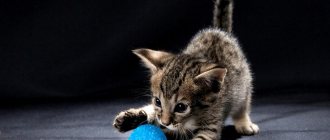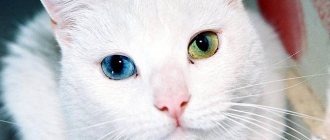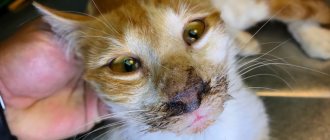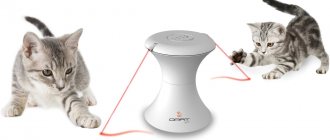When choosing a toy for a furry friend, the owner can rest assured: a laser pointer is a favorite pastime for cats of all ages. And the owners themselves love to watch how deftly the pet jumps after the beam, trying to catch the elusive target. Facts about the dangers of lasers make you wonder whether such a game is harmful. The answer is simple: being careful will turn chasing a speck of light into an exciting and rewarding activity.
Laser pointer for a cat: rules for safe play
To keep your cat safe when playing with a laser pointer, you should adhere to the following rules:
- Do not direct the laser beam so that it hits the cat's eyes. A single exposure injures the retina, and repeated exposures lead to loss of vision.
- Do not point the pointer at glossy or mirror surfaces. The reflected beam has the same negative effect as the direct one.
- If you highlight a wall with a red or green dot, an enthusiastic cat will run into it and hurt itself.
- The movements of the beam must be coordinated, otherwise an overexcited hunter will damage the situation.
- These disadvantages can be avoided if you purchase an automatic toy. The device is designed in such a way that the wandering spot is always directed towards the floor. A person may get tired, the hand will twitch and direct the beam in a dangerous direction. An automatic toy has no such disadvantages.
Read also: How to make a selling landing page
Safety rules during the game
It is best to purchase a low-power device for playing with your pet.
Any game should be approached wisely, because often fun turns into tragedy: losing coordination, the cat is injured, bumping into furniture, falling from a height and causing serious injuries to itself. A laser beam hitting the retina of the eye can result in irreparable consequences, even if done accidentally. To benefit from training and not put your pet at risk, you need to remember a few rules.
- Never point the beam at your pet's face. Even short-term laser exposure is dangerous for the eyes, and regular and intentional exposure will only increase the risk of damage.
- Use a low-power laser. Only ordinary cheap pointers with a power of 1-5 mW are safe for playing with cats. In addition, too bright a beam can scare the animal.
- Do not shine your pointer on mirror surfaces. Reflected laser is just as harmful to vision as direct laser.
- Coordinate the movement of the beam. You shouldn’t randomly turn the flashlight in all directions: when chasing the “target”, not only the cat, but also the interior items will suffer. You should also avoid hitting the wallpaper with the beam - the pet may hit the wall hard with acceleration.
- Do not play near open windows. An angry pet may hit the glass or jump out of the window, so for additional safety it is recommended to install a mosquito net.
Of course, we must not forget about the main motive of entertainment. Chasing a laser spot, cats are not just playing: the animals perceive the process as hunting. To prevent your pet from being disappointed, each time being left without prey, it is important to reward him with a “trophy”: treat him with a treat, cuddle him and praise him. At the end of the game, you can transfer the beam to the ball that the cat usually plays with, or to another favorite object. This motivates the pet to continue playing and helps develop the hunter's talent.
Is laser dangerous for cats?
Many veterinarians believe that lasers can harm furry pets. By pointing a laser pointer at the kitten, we tease it. He chases the beam like it's prey, not for play, even if he's having fun. A kitten will never catch a laser beam; this is an unattainable goal. A cat will not be able to satisfy its hunting instinct if it catches a luminous beam. Many cats understand this and stop chasing the laser. But others find it very upsetting and may cause them to behave badly. If you notice that your cat has started acting up, you need to stop these games and give her another toy.
In order not to tease the kitten in vain, he needs to be given a treat after playing with the laser. You can replace the treat with a ball or other toy. Thus, the hunting instinct will be satisfied.
Read also: How to make text borders in Word? —
Why do cats like lasers?
A laser pointer for cats is a great way to use your main talent: stalking and catching prey. Living in an apartment deprives animals of the need to hunt, and therefore they run after the elusive bright spot with excitement in their eyes. The skills of such games are important, as they help the predator pet realize its natural instinct. While playing, kittens learn and develop skills that are valuable for an adult animal.
You shouldn’t associate endless attempts to catch a “red fly” with the stupidity of cats: smart pets themselves ask their owners to play with them, bringing a flashlight in their teeth. So chasing the laser turns into a game for two: both the owner and the animal enjoy the process. In addition to standard applications, a laser can be used to teach a cat simple tricks.
View from the outside
Why else does a cat like to chase lasers? One of the reasons is the structural features of the eyes. There is a slight difference between the way our vision works and the vision of our pets. So, in human eyes there are more cones (cells that help distinguish colors) than rods (cells that help to concentrate on the movement of different objects), but in cats the situation is completely different.
What weather do you like? The answer will reveal your character traits An under-ice exhibition in the White Sea should draw attention to the problem of melting ice Anna Snatkina and Kirill Safonov are starring in the same series again after 14 years
They, on the other hand, have more rods than cones, which means their vision allows them to easily focus on moving objects. That's why when you use a laser pointer as a toy, it's like you're encouraging your pet to catch it.
Expert opinion
Should you use a laser pointer when playing with your pet? According to experts, such an idea is a kind of teasing. You do understand that he follows the red dot not because he is having fun or wants to play? It is controlled by instinct: it tells your cat to catch this moving prey and deal with it.
To be honest, laser color for your cat is an unattainable goal. Why? Despite his hunting skills, he will never be able to eat that red dot. Essentially, his predatory cycle will remain unfinished.
By the way, after a while, many pets realize this trick and stop being tempted by the laser. This can be very upsetting to other cats, and this can subsequently affect their behavior. Frustration over an unfinished predatory cycle can make your cat aggressive. If you notice this in your pet, stop using the pointer.
Our practical observations when playing with a laser pointer
And of course, I would like to give our practical observations when we play with our cats with a laser pointer.
Let us remind you that we have three animals and what is most interesting is that each of them reacts completely differently to playing with a laser beam.
Let's take a closer look at our favorites.
- Our oldest cat, Malva (a “noble breed”) reacts very well and plays with a red laser pointer . At the same time, the pointer with the diffuser, when white color is formed, it completely ignores. We can play for quite a long time, jump and run around the entire apartment. At the same time, no frustrations clearly occur - we dilute the game with the mouse.
- Our other cat, Patricia, an Abyssinian breed, on the contrary, ignores red pointers . She likes the white fish-shaped pointer. The batteries have already run out, so the outline is visible only in the dark, but this does not interfere with the game.
- And, finally, our beloved “felt boot” (a very calm cat), also an Abyssinian breed named Bluefield. He generally ignores any laser pointers . But he loves to play with mice and, especially, with a teaser stick with feathers. Ehh, we use up these teasing sticks very quickly - the feathers fly away in literally a week or two.
And what do we have?
Video: How big wild cats react to a laser dot
With the advent of laser pointers, many people began to play pranks on their pets. Cats especially often chase the pointer's beam. This toy completely captures the pet’s attention; he follows it around the house, not noticing any obstacles. This is how domestic cats show that they still have predatory instincts. An employee of an organization that rescues and cares for feral cats likes to play with his cat Jack, shooting laser pointer beams around the room. The pet is delighted with the game and chases the red dot everywhere. He decided to check how big wild cats react to a laser beam, whether they are interested in such a game and whether they will even notice this red dot.
The guy waited until dark, took his laser pointer and headed towards the cages where the big cats live: leopards, cheetahs, lynxes, pumas, lions and tigers. The cheetahs were the first to be tested, and they liked such an entertaining game. The cats ran after the laser beam with great pleasure. The video shows cheetahs running after the laser and showing great interest in it. They even stuck their paws out of the cage and tried to reach the point. The lynx also turned out to be interested in the laser beam, and the leopards also liked the game.
Advantages and disadvantages of laser pointers
The advantages of playing with a laser beam are the indescribable delight that your pet experiences while chasing an elusive moving dot. The cat gets very tired, falls asleep quickly and does not disturb its owners at night. An animal that spends its entire life in an apartment receives physical exercise.
Muscles, ligaments, and the musculoskeletal system work and become stronger. Excess calories are burned, which protects your pet from obesity and chronic diseases.
To prevent the cat from getting tired of the game, it is alternated with others - a wind-up mouse or a fishing rod with a fish at the end. However, thoughtless passion for lasers harms not only the physical, but also the mental health of the cat.
The pet becomes overexcited and may get injured. The unattainability of the goal makes the pet angry; he realizes his inability to catch the will-o'-the-wisp. The cat gets a nervous breakdown and loses interest in games.
How to reduce laser harm
The main problem that breeders and animal psychologists notice is that the animal’s needs are not being met. The animal’s brain and instincts say that this way he will catch something for lunch. The cat does not always understand that this is a game, even if it enjoys the process.
Some cats still recognize the deception and stop paying any attention to the laser. Other purrs feel stressed and frustrated. Over time, many begin to behave badly. For example, they begin to show aggression and damage things in the apartment. If you begin to notice changes in your pet's behavior from playing with a pointer for the worse, it is better to stop such games.
Or you can give your cat treats after these games. This way he will enjoy the hunt without even catching the laser itself.
Opinion about overstimulation of cats when playing with a laser pointer
It is noted that some cats may indeed behave unusually during play with the laser, as well as after it.
They can spin around in one place, run around your home looking for a victim in the form of a red dot, and cannot calm down for a long time after playing.
In addition, there may be some kind of looping on the laser pointer for a long time after the end of the game. For example, a cat can sit near the place where the laser lies or is hidden and wait for the next game.
Naturally, if you notice this behavior in your pet, then you can talk about several possible options:
- either you spend very little time with your cat playing such a game;
- or the cat may actually have a weak nervous system and becomes somewhat dependent on your toy.
There may be other options, but we don’t know about them yet. Maybe you have thoughts on this matter?
So, of course, if you observe inadequate obsession when playing with a laser pointer, then it makes sense to use only tangible objects for games (mouse, balls, teasers).
We play with our cats and we have never had such questions. We hope that you will also be fine with this item.
Opinion 3
Tags
Cats Why do cats chase between a cat and hold a cat why do cats chase your cat not your cat perceives your cat works How do cats see a laser pointer. laser pointers suitable remove the pointer. cat parents are familiar the eyes of cats and for cats the brain of cats produces Cat behavior cats attention. Raising cats Behavior cats Breeds of cats Breeds of cats
breedsfeedarticlesandconesfactmakescommenthomefastcontentshealthyhassticksdiseasesviewonlyworksforminusesprosrecordstreatment
Games with a pointer: harmful or beneficial?
For an active animal, such entertainment is a great way to get rid of excess energy.
If safety rules are properly observed, a laser pointer has practically no disadvantages. Chasing the beam trains reaction speed, attention and agility, and regular exercise keeps the animal in good physical shape. This is especially true for individuals prone to obesity. You can “turn off” your pet’s night mode by playing with it in the evening: a tired cat will sleep peacefully all night and will not bother the owner by running around the apartment. In addition, the pointer will “discharge” and calm an overly violent cat.
The safety of green lasers versus red lasers is a common myth: beams that are too powerful are equally harmful to the retina. However, when choosing a toy for a pet, you should give preference to the first one, since the cat’s eyes react better to green color.
In addition to the standard laser pointer, pet stores sell an automatic toy that allows you to keep your pet occupied while the owner is away. The mechanism generates a beam that moves in different directions and “controls” the cat instead of a person with a flashlight. You can run the device in manual and automatic modes, or set it to a timer. But since the trajectory of the laser beam is unpredictable, it is better to use the toy under the supervision of the owner.
Return to contents
Why a pointer for a cat: harm or benefit?
A speck of light moving chaotically across the floor resembles a small creature that the cat happily hunts for. The pet is driven by the instinct of pursuit; the lack of a three-dimensional form does not matter. Active play allows you to fight the main enemy of living in an apartment - adynamia. A teasing toy helps prevent obesity. The pet gets tired and quickly falls asleep.
The automatic laser has multiple speeds and timer settings, providing up to 16 operating modes. You can turn on the toy and go about your business. The pet will be so busy that he won’t care about anyone.
However, cat owners who have tried the teaser on their pets believe that the toy is dangerous for cats for the following reasons:
- The laser beam can burn the retina of the eye, and the cat may lose sight. Even when a bunny is reflected from a glossy surface or mirror, significant damage is caused to the eye.
- The pet bumps into furniture while jumping and may fall out of an open window.
- The game has no logical ending. The cat cannot catch the light spot and eventually becomes frustrated.
Safety Tips
In order not to harm a meowing pet, you must strictly follow safety rules. During the game, it is important to pay special attention to 2 important points.
1. Don't shine the light directly into your cat's eyes—even toy lasers emit incredibly bright light that can cause vision problems or even damage the eyes.
2. Provide your cat with plenty of other toys. When the laser is the only entertainment, frustration is likely to begin to build in the animal.
If you have a cat, then you know their passion for small boxes and secluded places. Probably, owners of cute purrs will also be interested in knowing why cats love secluded places: scientists name several reasons.
Dangerous for eyesight
It should be remembered that the laser should not hit the retina of the eye; even the reflected beam is dangerous for vision. The higher the laser power, the higher the danger, so when choosing a laser for a cat, you need to choose one with the lowest power.
color vision of cats
Which beam is better red or green?
There is an opinion that the green color of a laser is less dangerous for a cat’s vision, but this is a myth, it all depends on the power.
The cat may get injured
Yes, this also happens, unfortunately, despite all the dexterity of our furry friends, in the heat of their games they may not calculate the strength and hit themselves painfully.
Therefore, you should not point the laser at mirrors or towards shelves/chests of drawers where there are fragile objects that could fall and injure the cat. When playing, be careful.
Stress
Remember, cats are very vulnerable creatures; anything can cause them stress. It turns out that some purrs develop a feeling of self-doubt due to the fact that they are chasing an unattainable goal.
Our cats are hunters, instinct tells them to catch prey, but the cat never manages to catch the luminous beam, dissonance arises, and as a result, stress.
But this is fixable, so that the cat does not worry, you can end the game by pointing the beam at a piece of your favorite treat or a toy, for example, a mouse, then the cat will think that the hunt was fruitful.
Impact of pointing on vision
There have been many extensive investigations into how laser beams affect the human eye. They formed the basis for standards and safety concepts, including maximum permissible exposure doses, acceptable wavelengths and exposure times. Much of this research was carried out on primates with visual organs close to those of humans.
However, there is no public information about such studies specifically regarding cat's eyes. They are known to have significantly better night vision, but this does not necessarily indicate high sensitivity to coherent radiation. At the very least, the fact that they see reliably during the day indicates their ability to withstand high levels of daylight intensity. Briefly, the similarities in the work of the human and cat's eyes look like this:
- Retina. Living tissues are identical in animals and humans. Probably, the limits of safe exposure to it are similar. In other words, the same laser dose that can cause damage to the human retina is likely to cause similar damage to the tissue of an animal's eye.
- Lens. Focusing abilities are almost equal.
- Pupil. An animal with a larger pupil will receive more light only if the diameter of the laser beam is larger than the diameter of the pupil. The light beam from the pointer is very narrow, so the conditions for entering the eye are almost the same.
What's on a cat's mind or how to read your pet's thoughts
We recommend reading: How to care for a cat's fur during shedding
This means that most animals should have a similar threshold for thermal damage to the retina than humans. But there is another factor that influences perception. The cat's eye has a reflective layer behind the retina called the tapetum. Its task is to reflect light back onto the rods and cones and thereby increase the night sensitivity of the organ. The laser beam is also reflected by the tapetum, so we can conclude that the cat's eye is more susceptible to traumatic radiation.
Therefore, for the game it is better to use a laser pointer specially designed for this purpose and intended specifically for cats. Only in this way can the necessary security be ensured. In addition, you should never point it at the animal’s face or eyes; the beam should only be projected at inanimate objects in the pet’s field of vision.











